No, consumers didn’t suddenly flock back to the mall. That was just a media joke. They bought online more than ever. Sales at department stores fell.
By Wolf Richter for WOLF STREET.
The retail sales data, reported today by the Census Bureau, are based on surveys of about 5,500 retail businesses across the US, what they said their sales were. The measure is designed to track how well retailers are doing by retailer category, and we’ll get into those categories in a moment.
Another measure tracks spending by consumers, based on surveys of consumers. It’s reported separately and comes in an inflation-adjusted version. But not today (here’s June’s “Real” Consumer Spending).
Retail sales track sales of goods, not of services, and make up only a portion of what consumers spend their money on – and about two-thirds of consumer spending is for services, and spending has shifted back to services all year.
These are important distinctions between retail sales and consumer spending. I bring this up here because it always percolates through our illustrious comment section below the article.
Retail sales data is designed to look at the health of retailers by retailer category, not the health of consumers, though we can draw some inferences from those retail sales about consumers.
Inflation at retailers = price increases. But where?
CPI inflation in July was 8.5% compared to July last year. Compared to June, CPI was flat. But this varied widely by product category. The CPI for services is spiking relentlessly but doesn’t figure into retail sales because retailers sell goods.
The CPI for gasoline: -7.7% in July from June; if gas stations sold the same volume in terms of gallons in July as in June, their retail sales of gasoline in dollars would have plunged by 7.7% from June. But they didn’t – they dropped by only 1.8%, as we’ll see in a moment.
The CPI for “food at home”: +1.3% in July from June. Which means, if consumers bought the same amount of food and didn’t shift to cheaper products, sales at grocery stores might increase by 1.3% for the month. But they didn’t. They ticked up only 0.2%, as we’ll see in a moment.
The CPI for durable goods: +0.3% in July from June and, after a decline in prior months, was flat with February. The spike in durable goods prices occurred in 2021 and has now largely settled down as inflation has shifted to services. Retailers that are selling durable goods (not food and gasoline) had relatively fewer and smaller price increases, if any, in July.
Sales at retailers.
Retail sales in July, at $683 million (seasonally adjusted), were flat with June but up by 10.3% from July last year, and up by 31.6% from July 2019, according to the Census Bureau today.
But gasoline prices plunged which cut the dollar-sales of gas stations; and new-vehicle dealers were woefully short on inventory (down by over 70% from 2019, in number of new vehicles) which handicapped their sales. So excluding gasoline and auto dealers, retail sales jumped up 0.7% in July from June.
Total retail sales:
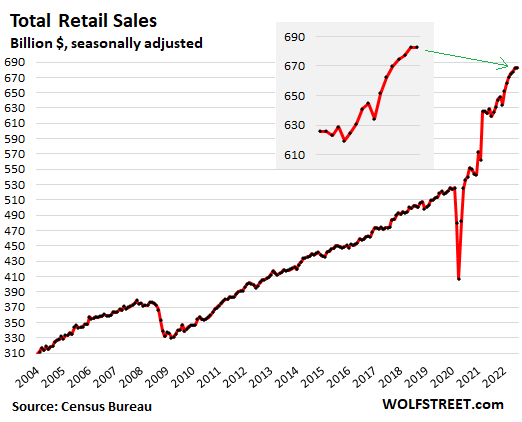
Retail sales minus sales at gas stations and auto dealers:
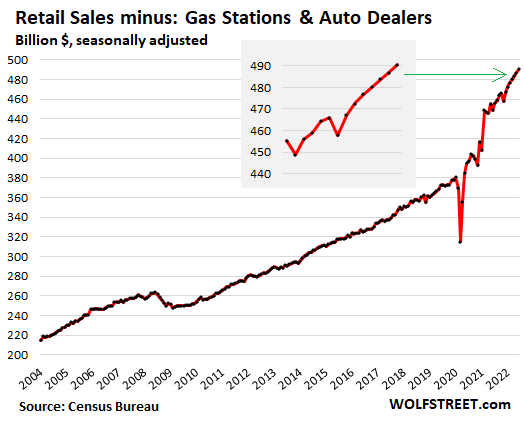
Sales by category of retailer.
Sales at New and Used Vehicle and Parts Dealers fell by 1.6% in July from June, to $125 billion, seasonally adjusted. Compared to July a year ago, sales were still up 2.1%, and compared to July three years ago, they were up 21%. This is the largest category of retail sales.
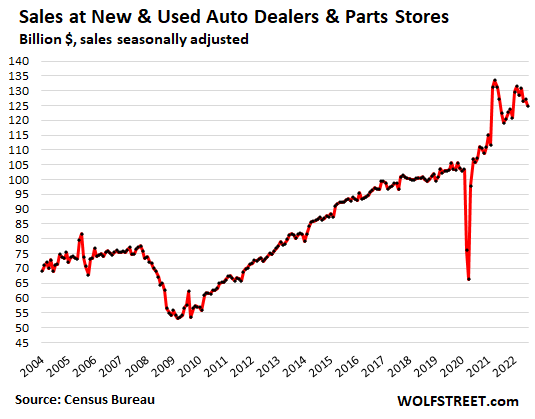
Sales at ecommerce and other “nonstore retailers” spiked 2.7% in July from June to a new record of $111 billion, seasonally adjusted, up by 20% year-over-year and up by 73% from July 2019, as consumers didn’t suddenly and inexplicably return to the mall – despite idiotic media hype to the contrary. See department store sales further below for how it worked out for them.
This includes sales by pure ecommerce retailers, and by the ecommerce operations of brick-and-mortar retailers, along with sales at stalls and markets:
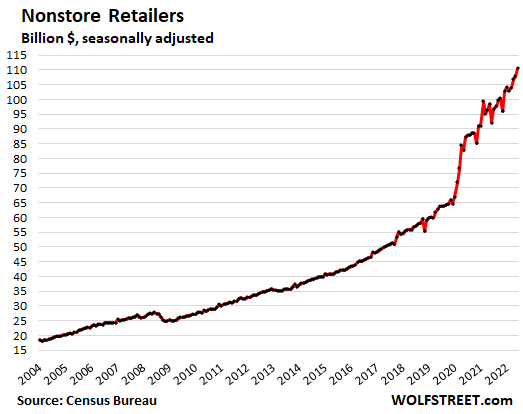
Food and Beverage Stores: Sales ticked up 0.2% for the month, to $79 billion, up 9.2% year-over-year, and up 22% over three years:
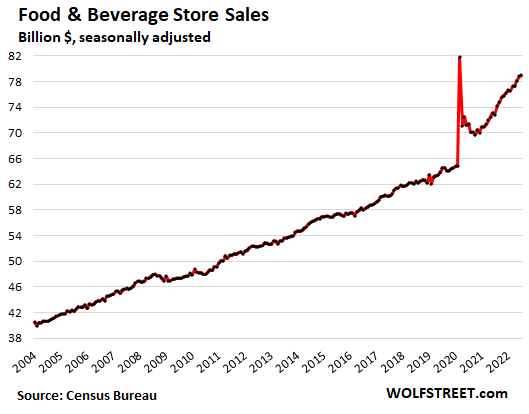
Food services and drinking places: Sales at bars, restaurants, cafes, cafeterias, etc. ticked up by 0.1% for the month, to a record $86 billion, up 11.6% year-over-year, and up 32% over three years.
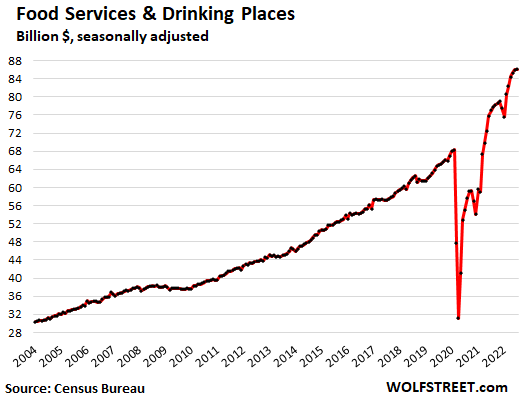
General merchandise stores: Sales fell 0.7% for the month, to $56 billion, and were up only 0.9% from the stimulus-miracle last year, and up by 15% over three years. Walmart and Target are in this category, but not department stores:
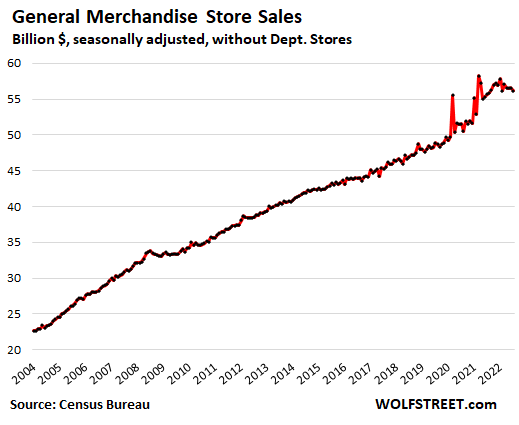
Gas stations: Prices plunged in July, and yet sales fell only 1.8% from June, seasonally adjusted, to $67 billion, the second highest ever, behind June. This was up by 40% from a year ago, and by 57% from three years ago, driven by the spike in prices that has now somewhat abated:
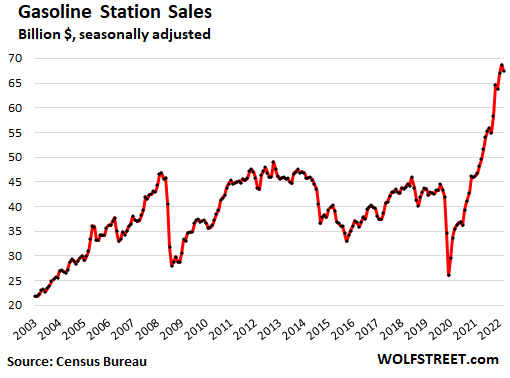
Building materials, garden supply and equipment stores: Sales jumped by 1.5% to $43 billion, seasonally adjusted, up 10% year-over-year and up 37% over three years:
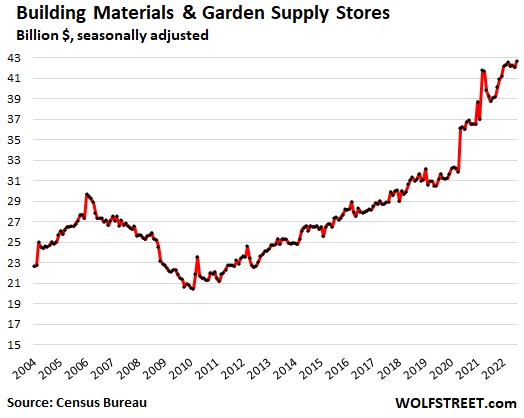
Clothing and accessory stores: Sales ticked down 0.6% for the month to $26 billion, up 2% year-over-year and up 15% over three years.
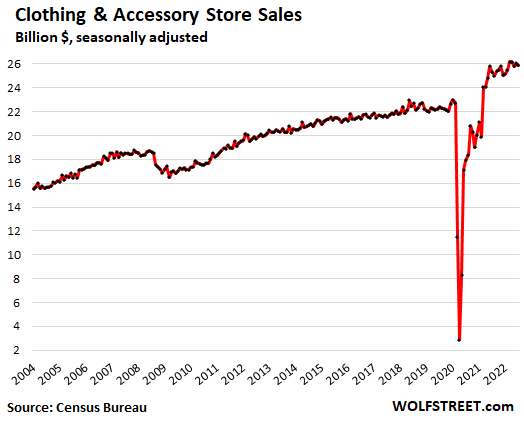
Miscellaneous store retailers (includes cannabis stores): Sales jumped by 1.5% for the month, by 18% year-over-year, and by 50% over three years, to $16 billion. This category tracks specialty stores, such as arts supplies stores, brewing supplies stores, etc., and cannabis stores, which are the hottest trend in brick-and-mortar retail:
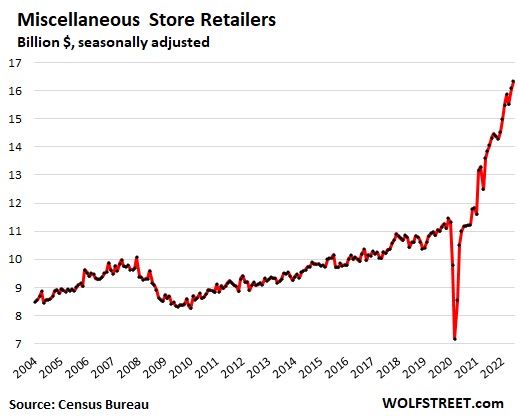
Furniture and home furnishing stores: Sales ticked up 0.2% for the month, to $12 billion, up 2% year-over-year, and up 20% over three years:
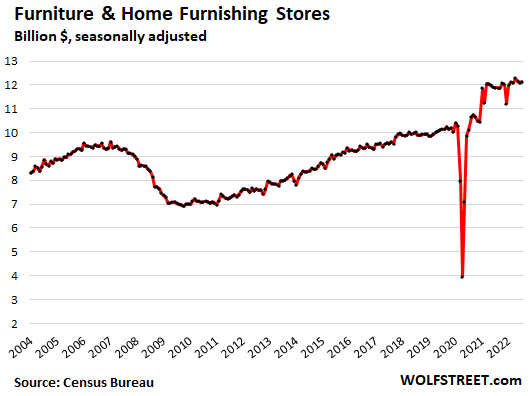
Department stores: sales fell 0.5% for the month, down 1.4% year-over-year, and down 3.3% over three years, to $11 billion. Compared to the peak in the year 2000, sales were down 44% as thousands of stores have vanished amid an endless series of bankruptcies and liquidations as Americans have chosen to buy their department-store stuff online:
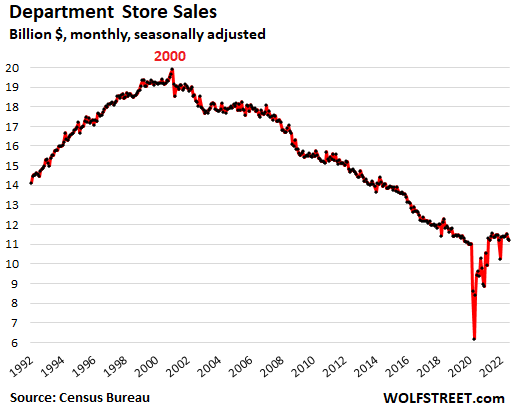
Sporting goods, hobby, book and music stores: Sales ticked up 0.1% for the month, to $9.2 billion, up 4% year-over-year, and up 38% over three years:
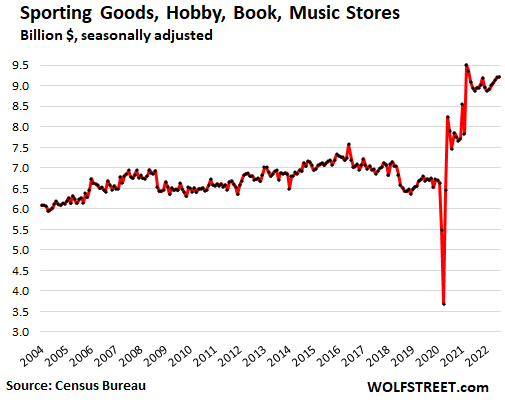
Electronics and appliance stores: Sales ticked up 0.4% for the month, to $7.6 billion, down by 10% year-over-year and down 1% over three years.
This category of retail stores covers only specialty electronics and appliance stores, such as Best Buy’s brick-and-mortar stores, or Apple’s brick-and-mortar stores. It does not cover other retailers that sell electronics and appliances, such has Walmart, and it does not cover ecommerce sales of electronics and appliances:
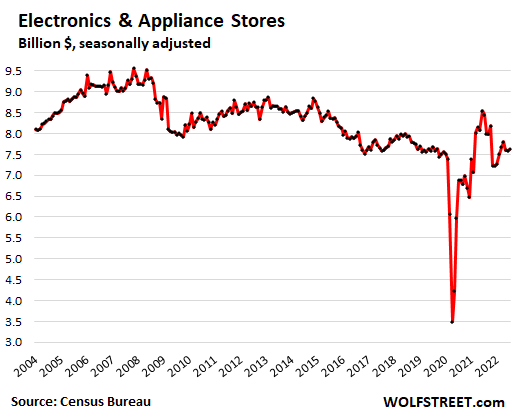
Enjoy reading WOLF STREET and want to support it? You can donate. I appreciate it immensely. Click on the mug to find out how:
![]()


I always avoided retail sales. Telling a customer to get lost and don’t come back, doesn’t help in retail.
But in wholesale/manufacturing, carefully selecting your customers and learning to say “NO” is vital if you plan to survive.
e.g. years ago, we reviewed selling to Home Depot, but they were SLOW PAY, they were erratic, always treating you like they were doing you a favor, so we completely dropped the idea. Anything they buy from us now, is marked up by someone in between, by us and for us, on a “take it or leave it basis”.
I hope none of that stuff is their re-branded Everbilt and HDX garbage! I could never figure out the chicken and the egg with HD products. Are they trying to drive out the quality stuff in favor of their poorly built junk, or are they refusing to negotiate with quality product manufacturers and left with nothing but their store brand junk? In any event, if I want junk, I go to Harbor Freight and pay junk prices!
Hey now…Harbor Freight sells decent tools at amazing prices if you only use their stuff lightly and periodically for personal use. They just opened a new store near me and it’s my go-to.
My town has a used hardware and tool store that specializes in lightly used tools and equipment. Granted, the quality of those items vary from awesome rare finds to total crap depending on what is in stock at the moment.
IMO while some quality improved, most of their stuff is still junk, yet prices are far from being as low as they used to be. Saying “buy cheap buy twice” fits that store well.
You can also buy 4-5 $15 on sale angle grinders and have a different wheel on each one. Faster work and half the price of a Bosch. Had a friend in metal fabrication biz trying that….haven’t seen him since back went out (2014) so I don’t know how it worked long term. I sure brutalized one on container project that finally killed W-2 back for good and it held up….thick Korten Steel cuts….bridge making stuff.
I bought a socket set at HF once. It had various metric sizes EXCEPT 12mm, which is the most common one you need. That store is a great microcosm of the US today, cheap junk and/or a scam.
Every tool brand you’re likely to see in an orange or blue building box store originates with a tool group that owns or licences the well-known names. Techtronics (TTI) LTD of Hong Kong owns Milwaukee Electric Tool Co, which sells more cordless tools in North America than anyone else as of 2016. They are not made in Milwaukee. They also license the Ryobi name and make badged Ryobi tools sold exclusively at Home Depot. They also license the Ridgid name from Emerson Electric, and make all those orange Ridgid tools, also exclusively for HD. Ridgid “red” tools are made by a subsidiary of Emerson for the professional plumbing and electrical/HVAC trades, and are sold at wholesale supply houses. Hilti and Makita are about the only independent power tool makers that cater to general contractors. Not for sale at Lowes or home Depot. A vendor has to jump through purchasing hoops to get shelf in those stores.
Quality in general has taken a beating. Three TOTL DeWalt (owned by Stanley Black and Decker, as is Craftsman) power miter boxes are being recalled because the blade safety guard can fly off and hit the operator. Now the safety features are out to get you.
Techtronics owns Milwaukee!……shit!…..these MBA types just throw anything together based on whatever shit it is they are “taught”. I think a Greeting Card outfit should own a car company..makes total sense, right?…..that’s if the “numbers” and whatever other weird shit works out.
No wonder things are fucked up. My back’s total trash so I’m just an observer now, and sure glad for that. Also statistically have only 5-8 years to live and glad for that too…..AND exactly when I go will be MY decision and not the hopelessly MBA/Lawyer confused Docs/scientists.
What a fucking mess, between the financial bunch, “law” bunch, and the advertising bunch running the whole show.
A trained manager is considered able to manage anything….yeah, right…..a law degree and an MBA makes one a genius.
“All the real talent is siphoned of into the arts and sciences, and that leaves the dregs to put it all together”
-Bucky Fuller 60’s
As I’ve been saying for years, “code” is cheaper than making switches…..I’m sure someone is writing the code for your finishing nails as we speak, and some fossil fuel guzzling machine is spitting them out, under the watchful accounting and law books of above mentioned genius.
At least people can spot and swipe his $38K Rolex….makes me feel a little better about the proliferation of his species.
Harbor Freight has a place. When you need a throw away tool or you’ve forgotten something on a job site and the HF is closer than where the real tool got left.
Most contractors in my area use DeWalt or Milwaukee. I used to run Makita way back when they were battery tool pioneers. Now they’re too hard to find, so it’s Dewalt now with a few specially Milwaukee tools that just work better than anything DeWalt makes. Makita is great for a general contractor but not enough specialty tools for most trades. I know some finish carpenters that use Festool. I actually have some Ryobi tools too – nothing I would really bring on a job, mostly around the house tools that get used too infrequently to justify quality ones.
The general hardware quality at HD is what is just awful now.
I’ve noticed bad steel in fasteners of all sorts. Heads that twist off of screws too easily, finish nails you can’t drive into old wood at all, etc. They’ve lost interest in what builders think of them and their products because they’re too busy chasing market share and pleasing the financial types instead. The fit and finish of their hardware is mediocre. I miss real hardware stores, we had the world’s best. Now we have Nailmart.
rick m,
I used to buy literally billions of fasteners, made in North America. Then years ago all the suppliers started sourcing from the Orient. Over there the idea is that in manufacturing, you screw the fastener in once, on the assembly line, with the force set just right. Whether for local use or export there was no difference in quality.
I used to buy injection molds and dies from over there too; at that time they asked you if you wanted ‘Hong Kong’ grade or American grade. The difference of course was if you had to run an HK grade mold or tool over here it would squash in the machine unless you had ‘the touch’.
In the late 90’s I was doing what a mechanic buddy called “creative misuse”. I was wiggling a drill bit to make the hole bigger rather than go hope there was the right sized bit in the communal box. The damn thing BENT! I had NEVER seen that before, showed a coworker in amazement, and he seemed kinda so-whatish and I asked him where central supply got our bits. Said he didn’t know but we got a good price on a special alloy of balsa wood and silly putty. No doubt some MBA got a promotion for saving money somewhere.
I’ll cool the rants now, crapp like this is probably bad for my old bald head.
But I bet blaming the last guy who worked on something is worse now than ever before. Managers blame the “consulting” outfits I bet. (that is also another HUGE useless business in case you haven’t noticed.)
Must be because of the tightening financial conditions as Bowell puts it.
Hahaha, markets have been refusing to transmit the Fed’s monetary policies to the financial conditions, and they’re still loosey-goosey, though a little less than they were last year. And that’s what you get. There is no landing at all; demand is still flying high.
Are you still holding on to the idea that the Fed has somehow miraculously become heroic about inflation after July’s show of timidity? If not, what would they have to do to change your mind?
Only people under consensual hallucination would think of it as “July’s show of timidity.” It’s your own brain that is playing tricks on you. Tightening deniers have been ridiculously wrong since late last year, at every step along the way. Consensual hallucination is a powerful trip. So enjoy.
I don’t deny the tightening. The extremely timid tightening has taken place and is taking place, exactly according to the extremely timid schedule (QT) and as and when announced (rate hikes). I’m just pointing out that it is being done timidly, and that the Fed’s messaging–especially in July, both the amount of the hike and the weak messaging in the presser and the minutes–reflects this, and so does the market’s reaction.
You people said a few months ago that the Fed would never be able to hike rates because it was trapped or whatever. And that it would never do QT. So now, after it had hiked four times, including two 75-ers in a row, and you call it timid? You tightening-denier trolls are a handful.
We visited Haight Ashbury in 1969. Everyone was away at Woodstock.
It all depends upon inflation.
Fed can’t keep their eyes closed and ignore the inflation numbers.
They did for sometime naming it transitory though.
It’s not that the Fed has become “miraculously heroic”, it’s that they don’t have a choice here. The Fed was only able to even fantasize about such ridiculous loose monetary policy in the past due to low inflation. Now reality has hit and inflation is crushing the US economy and the majority of the US population. This never ends well if it’s not confronted aggressively–you wind up with social unrest, a ruined currency and a population unable to pay its bills. Runaway inflation has done more than any war to bring down great empires of the past, and the USA has no special protection from that, if anything we’re even more vulnerable with our trade deficits. There’s no heroism to consider here. The Fed has to continue interest rate hikes and QT, there really is no alternative for the first time in 40 years.
An interesting question for one of those consumer surveys might be “have you increased ecommerce purchases due to the price of gasoline?”
We have. Even paying for the shipping on most items is cheaper than going to the store to purchase it. Of course, that is because we live in a rural area and the nearest department store is over 15 miles away. And we still have to go to town on occasion, but we coordinate our purchases into a single trip.
It makes sense. If you include the value of your time, ecommerce wins big. Figure you’re saving at least 2 hours even if the stores are close by. All the wandering around drives me crazy.
Looks like there is no sign slowing down this freight train. Jerome can raise rates all he wants now.
Always crazy to see how much above the 2019 trendline most of these retail sales categories are and that they continue to remain high or are going higher. Looks like we will never go back to that trendline despite slowing population growth.
It appears inflation and other crazy variables from the last 2 years are distorting the trendline in most categories. Online and cannabis of course are the new deal.
These sales are measured in dollars of course in most cases, not the actual compared volume of merchandise sold. For instance, building supplies have inflated exponentially in two years. Are actual supplies flowing out the door at a higher or lower rate?
My last ten years working was in the supply chain of a large retailer. The stores were posting increases in sales, while the throughput in units was actually lower. The prices had increased, that’s all. Retail deals in sales measured in dollars. Supply chain deals in “price per unit”, and knows exactly if the store is selling more items or not.
My thoughts exactly. I remember thinking in 2019 that things were getting a bit over-heated. And here we are.
Sir,
Your research and presentation are SUPERB!! THANKS, much.
Consumerism is alive and well looks like.
Credit card volumes need a look, I think.
Supply chains must be repairing if folks are buying so much stuff, except for autos of course.
ursel doran,
“Credit card volumes need a look, I think”
Q2 credit card balances (red line in chart below), at $887 billion were still down by 4.3% from the peak in Q4 2019 and just a hair above where they had been in 2008, despite 14 years of population growth and inflation (my report).
Raging inflation is responsible for much of the increase in Q2, according to the New York Fed’s Household Debt and Credit Report.
Credit card balances include balances that are paid off at due date the next month, every month, so that no interest accrues. Many Americans use credit cards purely as a payment method, and not as a borrowing method.
The total amount paid with credit cards for goods and services in the US is about $1.15 trillion per quarter, nearly all of which was paid off the next month, except for the $46 billion by which total credit card balances in Q2 grew. Which shows to what massive extent credit cards are used as payment method, and to what small extent they’re used as borrowing method, which makes sense, given the usurious interest rates.
Other consumer loans (green), such as personal loans, payday loans, and Buy-Now-Pay-Later (BNPL) loans, all combined, rose to $470 billion in Q2, below where they’d been 20 years ago, despite 20 years of inflation and population growth.
Never a fan of asking you to produce charts. More of a general concept question. My best friend just shocked me when he shared he has a second on his home. I thought those went away a long time ago. Then my friend in the mortgage business mentioned that the VP shared they are going to start aggressively marketing 2nds instead of HELOC loans. Are there any good metrics to get details on quantity and volume of 2nds?
If you have lots of equity in a home, why not? OK, in the 12 non-recourse states you might end up with a recourse mortgage as your second, and that might be a problem. But other than that…
Say you bought a home 20 years ago, and the mortgage is paid down a lot, and the home price has risen, and you need $200k to start a business with, why not? It’s the cheapest funding for your business that you can get. Lots of people are doing that when they start a business.
Why this HB1 is a little different is 2nd mortgages.
A neighbor in 2008 had a 2nd and a 3rd mortgage before the house went into foreclosure. LTV of the 3 loans was 115%. None of the banks wanted to take a loss so they left the house empty for 3 years fighting. After two years a tornado blew part of the roof off which caused water damage as it was left open for awhile. Then a big blue 20×20 tarp sat on roof for another 12 months. Some local high school kids started to sneak into the basement and have parties and leaving beer cans and empty bottles.
Back then many banks were happy to give 2nd mortgage ups to 110% LTV.
It was crazy.
Hi Wolf.
Does anybody track credit card charges completely paid just before the monthly statement is tabulated?
I doubt it. As Wolf stated credit card use is down but some or nice chunk of that yield and volume has made it’s way into BNPL world
you can get repair loans, dental and cosmetic loans, everything ecommerce sold etc. via some bnpl outfit.
“…you can get repair loans, dental and cosmetic loans, everything ecommerce sold etc. via some bnpl outfit.”
Many years ago I was talking to a contractor who said he finally got rich when he started offering financing to customers. His customer base exploded.
It’s the difference roughly between the total amount charged (=$1.15 trillion on average per quarter) and the amount added to credit card balances (=$48 billion).
I don’t have exact numbers for Q2 in terms of total amount charged. So I used 2021 figures (from Fitch). For the year 2021, Americans used credit cards to pay $4.6 trillion (= $1.15 trillion per quarter on average). So that’s what flows through credit cards to pay for whatever. But only the increase in the balance is the amount they borrowed of this amount. So in Q2, roughly, the amount they paid off in full before interest accrued was about $1.15 trillion minus $46 billion = $1.1 trillion.
Does purchasing the product online, and then going into the store (say HomeDepot) to pick it up, count as an online purchase or a store retail sale?
From a retailer’s perspective, that sale is booked through an ecommerce platform and should be recorded as such.
On a side note, as a midsize Canadian general merch retailer, our ecommerce sales are not trending up, overall sales are down 15% nationally yoy, and we’ve a surplus of inventory right now that we paid inflated prices for… and demand is slowing = huge margin risk.
1) The Yangtze river is drying up. Temp are rising > 40C for nine
weeks in southern China. Commerce on the river is limited.
2) Nuclear, hydro and coal plants produce electricity at lower capacity.
3) Water, food and rice shortages in southern China..
4) Foxconn shut down might affect AAPL sales in Xmas 2022.
5) The European drought cont. A warm winter might follow.. Since natgas
storage in Germany reached 70% (???), Germany might escape the grip of the Russian bear.
6) In 1976, during the oil crisis, Europe experienced a worse drought !
Opposite thinking forecasts are for colder winter north, continued dry in south…..La Nina is the crux…
Yep. I saw that Germany nat gas is at 75% towards full capacity. I think they will be okay.
Understand the detail to get the whole picture….as explained by Jim Rickards ..
The headline says “Germany reaches 75% gas stocks target ahead of schedule.” This sounds like good news.
German gas storage capacity is 23.3 billion cubic meters, which is about 20% of the actual 100 billion cubic meters of gas that Germany used in 2021. In other words, the 75% storage target is 75% of 20% of the gas actually used or 15% of the gas needed. That leaves an 85% shortfall relative to requirements.
Lots of natural gas is available to Germany at any time, at the market price, if they pay Gazprom in rubles. They have refused.
You’re totally off with the first one at least–we literally just yesterday went over a major specialist’s report on the Yellow and Yangtze River situation in China (one of our client’s distant supply chain points depends on goods shipped along the rivers) and while part of the Yangtze is stressed, it’s mostly the tributaries in the less commercial regions. The heart of the river is in better shape, and more important the restoration efforts along both have been helping to relieve the vulnerability to these climate stresses. Also there’s actually been above-average rainfall lately mainly on the Yellow River but stretching into several additional tributaries both of the Yellow and the Yangtze. It is absolutely NOT drying up and this alarmist exaggeration just misinforms companies and investors. There are some supply issues for goods there but these are mainly COVID-related, and on this China is finally relaxing some of its COVID policies as the baseline public health systems and better immunity are protecting against COVID-19 mass casualties.
If anything it’s the Colorado and Salt Rivers in the US that really are drying up, and they aren’t the only ones. At the rate Lake Mead’s water level is dropping they’ll seen be solving half the cold-cases from the glory days of the Mob in Vegas as the bodies in the barrels keep getting fished out.
Thanks ME for your thoughts on US retail sales.
But aren’t sales essentially flat? If inflation was 9% then we just paid more for the same thing. In other words, we haven’t reduced our demand based on price – yet. We are humans so we want what others have. We redo our perfectly fine kitchens to stay with the trend. But trends are created to keep us shopping. And now how far can consumerism go? Will we borrow like crazy to keep buying stuff we don’t need? If yes then the Dow is going to 40K. Who really has more power – the fed or the consumers? Home Depot has not sent me a 10% coupon for a long time. So they are not hurting yet.
Inflation adjusted earning can only fall no matter what the talking heads on Wall Street (Fraud Street) try to con the feeble public into believing. How can earnings possibly rise if wages are losing pace to inflation? This was the reason the stock market got hammered from the mid 1970’s until 1982 back when the stock market was actually trading at fair market value unlike today where its at least twice fair market value.
TK,
“But aren’t sales essentially flat? If inflation was 9% then we…”
RTGDFA
That’s why I wrote it.
Are there inflation-adjusted sales figures? It seems to me that nominal data don’t mean much.
RTGDFA
(Read The G*d D**m F***ing Article)
Bottomline: As of now, consumers have not really pulled back big time else we’d have seen big slowdown. Consumers are spending like crazy. Vacation spots all full, restaurants are all packed,, airline tickets very high, hotels all booked. big wait/line to buy $50K cars. I see no recession/slowdown coming.
Talking heads in CNBC are talking about housing recession. What recession, homes are still selling as hot in southern ca. Volume may be down, asking price bit down but YoY price increase is still big.
Wake me up when prices come down to pre covid :-)
Curious to see how long this crazy spending continues for, especially in regard to vacation related items. Anecdotally, I’m vacationing more than I was for the few years pre pandemic despite the large increase in costs now, definately making up for lost time. My trips were planned in advance and I wasn’t going to back off just because of inflation. However, after my final trip for the year in September I don’t think I’ll be planning any more for a while and this is true for the few people I know traveling this summer as well. We could all be outliers, maybe everyone else’s wages kept up with inflation, but if not I think the slowdown in spending is just on a delay and will come eventually.
Yes. Lots of revenge travel to make up for lost time and trips. And with more flexible Work From Anywhere policies, alot of folks continue to ramp up their travels way more than before.
We need the fed to stay on track and continue to raise rates and QT, to help get some liquidity out of the system and help shift the mindset of the consumer. Because many people definitely feel rich right now as evidenced by the above charts.
And as stated in previous articles, a recession is 50% psychology, which is likely needed to curb inflation (for those that don’t believe in soft landings). Sometimes it’s better to get the wheels down on the deck than miss the runway and have to do another pass around the airport.
I have said it before, the reason people are spending is that home equity. They feel rich. Combine that with a solid jobs market and raises and everyone feels rich.
The Fed will need to do a little more damage before things start to trend back down.
@gametv
Aren’t a ton of those homeowners now underwater though, with the way yields are rising and prices are plummeting? (Should’ve happened long ago, with a housing bubble this stupid.) The Millennials who FOMO’d in over the last 3 years esp have been hit really hard. Plus the property taxes and insurance costs have been through the roof. I just don’t see how the equity would make so many people “feel rich” when their costs have gone way up like this, seems that would outweigh a lot of the “feel richer” feeling. And as for raises–maybe for starting salaries for someone taking a shift at DQ, but for those of us with years vested in a company, raises haven’t kept up anywhere near enough with inflation. And it’s not so easy to just switch jobs the way the media makes it seem, there’s a ton of complications for specialized workers that make that in practice very difficult.
Agree the Fed needs to stay tough with the interest rate hikes and QT. JPow maybe doesn’t need to imitate Paul Volcker to the letter simply because he has things like QT at his disposal which can achieve a lot of the tightening without jacking up interest rates to the same level, but he has to stay determined. The serious inverted yield curve lately suggests the USA likely is going to be facing a serious recession in early 2023, but that’s supposed to happen. It’s called the business cycle, and with a housing bubble and other ridiculous asset bubbles like this, it’s the only way to reset things to get to something closer to true value and price discovery.
I’d agree that consumers haven’t really pulled back as much as thought (that’s part of why inflation is still crushing the US) but I wouldn’t agree they’re spending like crazy. Not sure where you’re seeing this, but we absolutely are not seeing hotels and restaurants booked and packed like that, not even close. People are still going on vacation and eating out, but rents and the costs for people who FOMO’d into housing at the peak are starting to bite, not to mention for food and all the others items subject to this inflation, and there’s absolutely been some pullback in other areas of spending. Sales are flat or down, and the level of spending hasn’t fallen as much just because inflation means people are spending more dollars to get the same (or less) than before, and there’s only so much of it to go around with wages lagging inflation so much. A lot of relatives and friends out in Florida and California, and they simply can’t spend like they used to when their rent is up 20-30% for a modest 1 or 2BR apt., entertainment spending esp is way, way down.
More and more it’s becoming clear that there was massive fraud with the PPP loans which fueled a lot of this inflationary spending (a big part of the overstimulation) at the expense of a now $30 trillion national debt, but that particular punch-bowl is disappearing. Student loan repayments are still on pause but unclear for how much longer, and that too is fueling higher deficits–some are pulling back spending out of the sheer uncertainty of having to restart their student debt payments. As for sales on high-priced autos–Wolf has dissected that a lot and it’s largely due to the crazy supply shortages for cars. Sales volumes in general are down but yes, people are paying $50K for new cars because there are so few cars coming off the lots for the buyers who’ve been waiting for years to buy one. Bottom-line is, Americans’ incomes haven’t kept up with this inflation, not even close. So budgets are getting tighter and a lot of luxuries are being cut.
Reposting a comment from an earlier article:
Last week I stumbled on a Small Business Administration website that enables one to download CSV files of their database of all the PPP (Paycheck Protection Program) loans they made during the pandemic crisis.
Importing them into an SQLite database and running some queries, I find that in the Zip code of the light industrial park in the far Chicago suburb in which I own a “man-cave” office/workshop, the SBA doled out nearly $70 million in loans, and has forgiven about $65 million (Google “PPP loan forgiveness” to learn how that works).
The population of this Zip code is about 17,000. The number of jobs reported was 7,231 (some of the companies clearly employed people outside the Zip code). About $10,000 per reported job.
The number with ForgivenessAmount > $150k was 151.
The total forgiven for those loans was $52 million.
A very large fraction of these loans went to firms doing the kind of home renovation/construction work that, IIRC, was booming during the pandemic, so I find it rather curious nearly all the loans were forgiven. I wonder how much of this money found its way into the stock market, and into conspicuous consumption.
Thanks for info. That is crazy
Off topic.
From the Fed meeting minutes released today, the committee revealed that it expects the natural roll-off of MBS to fall below the $35B cap that starts in September. There was no mention of how the committee intends to make up the remainder of the cap (such as selling MBS).
Does this simply mean that we shouldn’t expect the MBS balance on the Fed’s balance sheet roll-off at the targeted $35B each month, even after the previously purchased MBS in the TBA market are settled and purchases go to 0?
They will probably allow it to be less than the $35B cap, because “soft landing.”
Johnny5,
During QE the scheduled purchases of MBS were about $50 billion or more every two weeks (over $100 billion a month to replace pass-through principal payments and to add new MBS balances).
The latest schedule (released Aug 11) was for $3 billion over two weeks, starting August 12.
The prior 4 schedules (for 2 weeks each) were for $6 billion every two weeks.
The next schedule will be released on August 25. It, or the schedule after that, may go to zero (no more MBS purchases). At that point, none of the passthrough principal payments will be replaced.
When that schedule with 0 purchases comes out, I’ll probably cover that.
MBS come off via pass-through principal payments, which could slow further as rates go up (refis down) and housing sales decline (mortgage is paid off). As the market figures out pricing, sales will likely pick up at lower prices, and these more normal-ish sales (at lower prices) would increase passthrough principal payments.
They mentioned selling MBS outright several times before, and they may eventually do it. They really want to get rid of the MBS because they’re so unpredictable. They want to have a Treasury-only balance sheet.
Wolf,
In every article where you mention the QE/QT, you point out how wrong the QT deniers have been. I guess there must’ve been a few people that denied that the FED would ever QT, but most people that talked about that stuff were saying the FED would never be able to complete QT, not that they wouldn’t attempt it or feint doing it. Do you think the FED balance sheet will ever be lower on a ten year look back basis? I don’t.
You just moved the goal post in perfect tightening-denier manner. The Fed never specified to what extent it would reduce the balance sheet. So now YOU get to pick what “complete” means and YOU get to decide whether the Fed gets there or not. Just give it up, it’s all the same pattern of the QT deniers:
At first they said, the Fed will never taper QE, and when it began tapering QE, they said it will never end QE, and then they said the Fed will never be able to raise rates, and when it ended QE and raised rates, they said the Fed is trapped and can never raise to 1%, and it can never start QT, and now that it raised to 2.5% and has started QT, they say that the Fed can never “complete” QT… You people are really a handful.
I didn’t move anything. I never believed that the Fed Funds Rate would remain at 0% forever. No serious person did. Secondly, logical analysis of the fiat monetary system suggests the debt has to inflate or the system implodes…
>The Fed never specified to what extent it would reduce the balance sheet.
Sure they did. Bernanke said QE was temporary and that they would be gradually sold back off. That was over ten years ago. There were people at the time saying he was lying. It’s as temporary as the gold window closing over 50 years ago. There’s still a chance…
The why’s of interest rate raises and QT are especially relevant. The stated and/or implied reasons are to ‘normalize’ interest rates (whatever that means) and to get a handle on inflation. Since you didn’t answer my 10 year look back question, do you think the current attempts to raise rates and QT will succeed in ‘normalizing’ rates and getting a handle on inflation?
US Govt has taught everyone in USA to live beyond their means and spend like a drunken sailor. If US Govt can get away with this why can’t US citizens who in the end elect the Govt.
Also consumers smelled blood and realized that all consumer debts, college tuition debts, home debts, auto loan debts, liters all debts can be forgiven or inflated away into oblivion. So why not spend and live king size and when it comes to payback, just elect a pro debt forgiveness Govt. This is literally sounding like demise of democracy. You cannot run any organization where employees elect the CEO.
All of this is possible because of our reserve currency status. This party will go on and the world will continue to subsidize US lifestyle and spending and it’s paper USS debt knowing that the debt will never be paid back or inflated away.
It’s so good to live in the USA.
“Shortage of New Vehicles”
For over 2 years straight, with no sign of letting up. Their model is broken. At this point, somebody could start a new brand and beat these idiots. What a clown show these twerps created.
If consumers went on a buyers strike and stopped buying new vehicles for six months straight with sales plunging 90% for six months, that would end the shortages, and it would allow everyone to catch up.
Hi Wolf.
About how many cars are junked each month/year?
“…sales plunging 90% for six months…”
This actually made me laugh out loud as I imagined the implications at the dealerships and manufacturers. It couldn’t happen to a better bunch, IMO.
Who are you kidding? The government would step in and offer tons of financial assistance, wage payment, grants and liquidity without need for repayment to save/protect the industry. They have done it before and will continue to do it. US government has a magic wand and decides who gets unlimited funds depending on the problem. Look back over the past 20+ years and you see a pattern.
I think that part of the equation with cars that people forget is that COVID caused everyone to stop using public transportation. So they needed cars.
The perfect storm of increased demand and reduced supply.
“ Sales at ecommerce and other “nonstore retailers” spiked 2.7% in July from June”
Various “ prime day” and/or back to school ?
This is seasonally adjusted, so back-to-school is figured into this. Not sure about prime day.
AAPL reached backbone #4 : Dec 8/9 2021 ==> 175.96/173.92.
Today AAPL close Apr 5/6 2022.
AAPL had three Last Point for distribution under the $3T top. Today LPSY
is the lowest.
BB #4 : Dec 9 2022 hi/lo ==> 176.75/173.92.
AAPL BB #3 : Aug 24/25 2020, 128.79/123.05. In June 16 AAPL dropped to BB #3.
AAPL accumulation is incomplete. It might drop to the weekly Aug 31 2020 fractal zone for more accumulation, in a wild roller coaster.
Why would natural selection favor humans biased toward overconfidence? Because those humans would grab mates, be soldiers, work hard for snazzy cars, and by the time the consequences fall upon the individuals and their habitat, the point is, their genes have been replicated. I know so many morons who fit that to a “T.” Not to be too anthropomorphic, but I think evolution doesn’t mind even the slightest bit when a die-off (or “recession”) happens. But in groups, humans, even the most macho of them, will stave that off (with various “social insurance” schemes) until the dry kindling is overwhelming.
I think you’re on the wrong site, dude. I remember a Saturday morning kid show where monkeys were fitted with musical instruments. They were called ‘The Evolution Revolution’.
In three months S hits the F. RE and construction layoffs will begin working their way through the system, as well as tech cutbacks. The big spenders will take a nose dive.
Its not hard to foresee this, unless you are in denial.
Yeah been thinking this too, and this might be connected with that inverted yield curve for the US which has been pretty striking. Even though US GDP fell for Q1 and Q2 I’d agree with NBER that it isn’t a recession because the jobs and spending picture has held up. But that’s already starting to change with the waves of layoffs and reduced demand–which is, being fair, what has to happen to puncture these asset bubbles. That said, I still think it’ll probably be early 2023 before the USA actually enters into a serious recession. The layoffs from the 2006 housing bubble began to start up by second half of 2007, but it wasn’t until next year that things really got nasty. I’d suspect something similar here, a lot of canaries in the coalmine but Q1 2023 before the recession really hits. Still, not an excuse for the Fed to get tepid. The stupidity of QE and ZIRP is what got us into this mess in the first place, and it’s only a deep cleansing recession that’ll get us out. Paul Volcker understood this in the early 1980’s, and it was indeed only the deep recession of 1982 and 1983 that finally brought inflation under control. The same here.
Almost all the shiny glass storefronts built in the last 7 years under mid rise apartments in the 1000-5000 square foot range around here in clown town PDX are empty except on a few well known streets.
Otherwise, some zoom care, some pet day care, maybe bad fast food, that’s it… maybe some mattress stores. No local flavor. Online retail was a hard core serial killer then the health scare took out most of the rest.
There is zero growth in cannabis retail because there is a moratorium on new licenses plus the longstanding 1000 foot proximity to schools, to day care, and to other pot shop restrictions. There is an incredible glut in supply here that has decimated producers and processors.
A restriction of 1000′ from schools…that should do it. Most kids can’t walk that far anymore.
Dry gulch Jerome with his twin pop guns , Diet QT and Rate Increases , had a run in with Black Bart the Consumer and his silver plated twin Master Cards. The result was Dry Gultch got his dime store vinyl holsters and belt shot off and was standing around at high noon in his Big Bird under wear.
Hahaha. Loved it.
“ The result was Dry Gultch got his dime store vinyl holsters and belt shot off and was standing around at high noon in his Big Bird under wear”
So ole Dry Gulch Jerome says to Black Bart, “ Yeah, ya got me… but say, can you spot me a new pair of pants on one of them thar shiny Mastercards…”
Black Bart says, “ I’d love to partner, but these here cards cost me 29% interest apiece…”
Dry Gulch Jerome says smiling, “ yeah, I know…”
In fairness he bought that vinyl gun belt at Harbor Freight.
E-commerce = card-not-present transactions. You are safer to keep money in a bank with no debit card being activated. Credit card transactions by law leave the liability on the issuer not the borrower. Debit card transactions leave all liability on you. So if you love to keep a lot of money sittin’ in the bank, report your debit card lost and NEVER activate the replacement. Never write a check from that account. Use a 2nd dummy bank account with little funds in it to pay bills or other Knick knack stuff. A debit card is basically a crack in the safe that can be exploited
I always just keep a couple thousand in checking and the majority in a savings account with a different account number, then transfer from savings to checking when needed. There was a fraudulent transaction on my card last year and the bank refunded me. Not a big deal.
Somebody gets your info and charges a Macbook to your debit card,, usually the bank has no problem not charging you for that. But if someone snatched $50k or $100k out of your bank acct,, that’s a whole ‘nother conversation. See that FDIC $250k insurance all bank accts have is only applicable in the event of bank insolvency, it doesnt cover thieves looting your funds. The bank has the option to make you whole again or not. So like I said, your main acct should be leak proof. Which means no mobile banking app ever being connected to it, no activated debit card, and no writing checks or receiving any direct deposits to it. The only thing going in or out is when you are inside the bank face2face with a teller. your secondary account is for auto-bill pays, paying mortage, car note, direct deposits, etc. You manually withdraw the funds in person from your main acct and then deposit the cash in ur secondary acct to cover all the day2day or month2month bills. This is the only way to fortify your wealth if the bulk of your wealth is sittin’ in a bank acct instead of under the dog house, behind some sheetrock, or inside a mattress
They are spending “more” of the less valuable $. Charts prove inflation, not consumption which is declining such as number of cars sold.
The same dislike for physical retail locations from Wolf and followers as usual. Enjoy the yard work, endless kid ball tournaments, and Netflix at home. The money spend traveling to tournaments for years, could pay the college tuition, I have done the math.
4 million people in the greater San Franciso, Oakland, San Jose area. 8 million in the New York City area. Yet these 12 million tell us daily how the other 315 million are clueless. I have lost respect for you Wolf, you are a permabear.
“you are a permabear.”
RTGDFA. If you cannot force yourself to read the article, then don’t comment on the article. Just talk about your new kitten, or something on that level. You just made an obliterating fool of yourself in public.
This article says that consumers are spending lots of money, and all my prior articles on consumers over the past two years have said the same thing, consumers are flush with money and are spending like drunken sailors. I even used that expression a while back. Consumer credit is in great shape, and I’ve been saying that for over a year. And consumers are working and making money and getting big raises. And that’s why I said that the US is NOT in an official recession.
The perma-bears out there have lashed out at me for being so gung-ho about consumers, but those are just the numbers that I report and analyze.
To call me a “perma-bear on an article on retailers and consumers is just braindead BS. You didn’t even read the headline.
Adios.